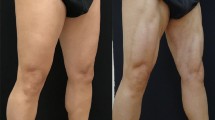Abstract
Background
Obesity and massive weight loss cause bulging and ptosis of the mons pubis. The pubic area can cause an embarrassment to patients. In some cases, the deformity can be seen even under clothing. Ptosis of the mons usually is addressed during abdominoplasty. The author presents a new clinical classification of mons deformity based on the amount of adipose tissue deposit and the degree of ptosis. A strategy of treatment to achieve a proper rejuvenation of mons deformities is provided.
Methods
Between 2004 and 2009, a total of 132 patients with pendulous bellies and mons pubis deformities underwent abdominoplasty and lifting of the mons. A technique using a dermal-fascial suspension with permanent sutures to hang the weight of the mons skin and subcutaneous tissues on the musculoaponeuretic system of the lower abdomen is described. The age of patients undergoing the operation ranged from 20 to 53 years. During the follow-up period (12–38 months), all the patients by the author, who reviewed their medical charts. A Likert scale and an evaluation questionnaire were used to assess the aesthetic outcome of mons lifting.
Results
All the patients who underwent lifting of the mons pubis were free of postoperative contour deformities and had a long-lasting outcome. At this writing, patient satisfaction has remained high.
Conclusion
The clinical classification and treatment guidelines reported are designed to provide simple procedures with minimal complications that have tremendously rejuvenated the mons.













Similar content being viewed by others
References
Lockwood T (1993) Lower body lift with superficial fascial system suspension. Plast Reconstr Surg 92:1112–1122
Lockwood TE (2004) Maximizing aesthetics in lateral-tension abdominoplasty and body lifts. Clin Plast Surg 31:523–537
Alter GJ (2009) Management of the mons pubis and labia majora in the massive weight loss patient. Aesthet Surg J 29:432–442
Gasperoni C, Salgarello M (1995) Rationale of subdermal superficial liposuction related to the anatomy of subcutaneous fat and the superficial fascial system. Aesthetic Plast Surg 19:13–20
Markman B, Barton FE Jr (1987) Anatomy of the subcutaneous tissue of the trunk and lower extremity. Plast Reconstr Surg 80:248–254
Avelar J (2002) Anatomy of the abdominal panniculus. In: Avelar J (ed) Abdominoplasty Without Panniculus Undermining and Resection. Editora Hipo’crates, San Paulo, pp 59–86
Agris M (1977) Use of dermal-fat suspension flaps for thigh and buttock lifts. Plast Reconstr Surg 59:817–822
Filho JM, Belerique M, Franco D, Franco T (2007) Dermolipectomy of the pubic area associated with abdominoplasty. Aesthetic Plast Surg 31:12–15
Dellon AL (1985) Fleur-de-lis abdominoplasty. Aesthetic Plast Surg 9:27–32
Conflict of interest
I have no conflict of interest to disclose.
Author information
Authors and Affiliations
Corresponding author
Rights and permissions
About this article
Cite this article
El-Khatib, H.A. Mons Pubis Ptosis: Classification and Strategy for Treatment. Aesth Plast Surg 35, 24–30 (2011). https://doi.org/10.1007/s00266-010-9552-4
Received:
Accepted:
Published:
Issue Date:
DOI: https://doi.org/10.1007/s00266-010-9552-4




